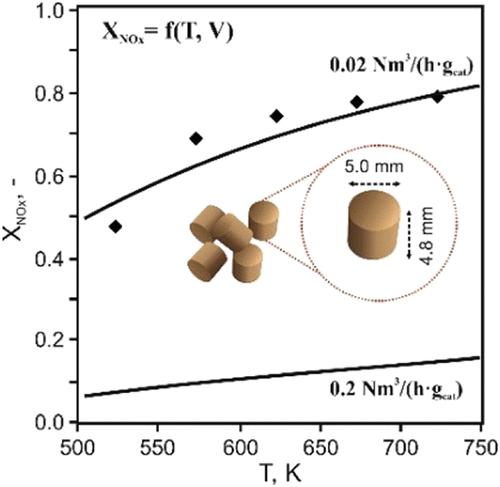The Effect of Diffusion Limitations on the NH3–SCR Process over a Shaped Fe-Modified Clinoptilolite Catalyst
IF 3.9
3区 工程技术
Q2 ENGINEERING, CHEMICAL
引用次数: 0
Abstract
Research was carried out on the catalytic effect of Fe-modified clinoptilolite in the selective catalytic NOx reduction by NH3 (NH3–SCR) in the real tail gas stream, taken from the Łukasiewicz – INS pilot plant for testing the ammonia oxidation process. To obtain a catalyst with the desired textural parameters and increase the acidity of a zeolite and the content of Fe3+ active sites, clinoptilolite was modified with iron using a two-stage method, including dealumination and wet impregnation. Catalytic tests were performed over the shaped Fe-modified clinoptilolite to study the effect of diffusion limitations on the overall NH3–SCR reaction rate. The effectiveness factor of the catalyst shaped into pellets was determined based on the Weisz modulus. It was found that diffusion limitations influence the rate of the contact process to a greater extent, the larger the size of the shaped catalyst body. The contact process over the pellets 5.0 mm in diameter and 4.8 mm high occurred in the diffusion regime, and the diffusion limitations were influenced more by Knudsen diffusion than by molecular diffusion. Simulation calculations of the relationship were performed for various sizes of the catalyst pellets. It was found that the temperature had an insignificant effect on the shaped catalyst’s performance within the considered “temperature window”. The pellet size and contact time proved to be significantly more critical for achieving high conversion.

扩散限制对异形铁改性斜沸石催化剂NH3-SCR过程的影响
研究了铁改性斜沸石在真实尾气中NH3选择性催化还原NOx (NH3 - scr)的催化效果,该尾气来自Łukasiewicz - INS中试氨氧化工艺。为了获得具有理想结构参数的催化剂,提高沸石的酸度和Fe3+活性位点的含量,采用脱铝和湿浸渍两阶段法对斜沸石进行了铁改性。在fe改性斜沸石上进行了催化试验,研究了扩散限制对NH3-SCR总反应速率的影响。采用Weisz模量法确定了球团催化剂的有效系数。研究发现,催化剂体尺寸越大,扩散限制对接触速率的影响越大。粒径为5.0 mm、粒径为4.8 mm的球团在扩散区发生接触过程,扩散极限受Knudsen扩散的影响大于受分子扩散的影响。模拟计算了不同尺寸催化剂球团的XNOx=f(T,τ)关系。结果表明,在给定的“温度窗口”内,温度对定型催化剂的性能影响不大。事实证明,颗粒尺寸和接触时间对实现高转化率至关重要。
本文章由计算机程序翻译,如有差异,请以英文原文为准。
求助全文
约1分钟内获得全文
求助全文
来源期刊

Industrial & Engineering Chemistry Research
工程技术-工程:化工
CiteScore
7.40
自引率
7.10%
发文量
1467
审稿时长
2.8 months
期刊介绍:
ndustrial & Engineering Chemistry, with variations in title and format, has been published since 1909 by the American Chemical Society. Industrial & Engineering Chemistry Research is a weekly publication that reports industrial and academic research in the broad fields of applied chemistry and chemical engineering with special focus on fundamentals, processes, and products.
 求助内容:
求助内容: 应助结果提醒方式:
应助结果提醒方式:


